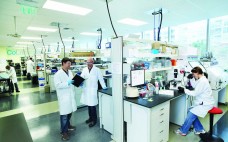In the past year, CPhI Worldwide (a division of UBM EMEA) has released reports on both the Indian and Chinese pharmaceutical markets, findings of which were presented at CPhI India in Mumbai in early December 2014 and shortly after CPhI China in August 2015. India Looking Outward to Innovate The Indian report, CPhI India Pharmaceuticals 2015: Industry Explorations, was developed by CPhI in partnership with Global Business Reports (GBR) to provide a comprehensive analysis of the country’s pharmaceutical market. Overall, Indian companies…
BioRegions
Can English Unite SE Asian Markets?
By 2016, the global pharmaceutical industry is expected to generate an estimated 30% of its total sales in emerging markets (1). After India and China, southeast countries such as Indonesia, Singapore, Malaysia, Vietnam, and Thailand are especially attractive markets. The Association of Southeast Asian Nations (ASEAN) Economic Community (AEC) consists of 10 countries united through regional economic cooperation: Thailand, Myanmar, Laos, Vietnam, Malaysia, Singapore, Indonesia, Philippines, Cambodia, and Brunei. The ASEAN Community 2015 (AEC 2015) initiative aims to form a…
To Serve and Promote: A Conversation with BIO’s President and CEO
BIO is the world’s largest trade association representing biotechnology companies, academic institutions, state biotechnology centers and related organizations across the United States and in more than 30 other nations. BIO members are involved in the research and development of innovative healthcare, agricultural, industrial, and environmental biotechnology products. BIO plays a leading role in shaping public policy related to the biotechnology industry — at the state, national, and international levels. Jim Greenwood has been BIO’s president and CEO for 10 years,…
A Case for Biopharmaceutical Operations in Low-Cost Countries to Maximize Return on Investment
A company’s success is associated with its growth. An expanding company hires more employees (full-time equivalents, FTEs) to support its commercial products, to develop new products, and to provide administrative services. As it grows, an organization can become more complex and its operations less efficient. Analysis of 2013 financial data showed that revenue of US biopharmaceutical companies increases with a growing number of FTEs at a slower rate than does cost (1). That study assumed that all US biopharmaceutical companies…
Bridging Innovation and Partnerships in Mission Bay: Bayer’s CoLaborator Program
Looking at the landscape today, it’s hard to believe that in 2004 the Mission Bay neighborhood of San Francisco, CA, was home to only two biotechnology companies. Over the past decade, industry-leading organizations across academia, clinical care, and research have settled in the area, creating a thriving ecosystem of more than 100 life science companies. Prestigious academic and research institutions such as The Gladstone Institutes and University of California San Francisco as well as life science accelerators such as QB3…
Creating Value Through Investment
During my MBA course, Professor Pierre Casse — then at the International Institute for Management Development (IMD) in Lausanne, Switzerland — regularly reminded us that one key to success was constantly finding new ways to “delight and inspire your clients” by creating value. SAFC achieved that objective in its “Overcoming Supply Chain Vulnerability and Lowering Risk in Biopharmaceutical Manufacturing” symposium 17–18th June 2014 in Turnberry, Scotland. Along with a day of industry insight, the event included a visit and tour…
The Rise of Biopharmaceutical Outsourcing to Indian CDMOs
India is becoming an increasingly attractive destination for outsourcing biotechnology services by global biopharmaceutical companies. As “Big Pharma” continues on its path of finding ways to lower costs for development and manufacturing of biopharmaceuticals, Indian contract development and manufacturing organizations (CDMOs) are being viewed as capable and beneficial service providers that possess the necessary technical expertise and regulatory-compliant facilities. According to its 11th annual report on biopharmaceutical manufacturing capacity and production, BioPlan Associates ranked India fourth in the world as…
Bioprocess Advances Drive Vaccine Manufacturing in Developing Countries
Advances in bioprocessing technology hardware and genetic engineering are expanding the geographic options for biologics manufacturing to include developing and emerging economies. Such advances are beginning to permit biopharmaceutical production in regions that previously lacked the technical expertise or quality processes to permit complex operations, monitoring, record-keeping, and oversight. Global demand by countries for in-country production of biological vaccines is increasing, so those products tend to be leading the way in terms of adoption of modern bioprocessing in developing countries.…
Optimizing for the Future
The 2013 biennial meeting of the European Society for Animal Cell Technology (ESACT) was in Lille, France this past June. While there, BPI editorial advisor Miriam Monge (vice president of Biopharm Services Ltd.) interviewed ESACT executive committee member Hitto Kaufmann, PhD (vice president of biopharmaceutical process sciences for Boehringer Ingelheim). They talked about some scientific developments being discussed at this year’s ESACT conference as well as Boehringer Ingelheim’s recent announcement about setting up in China and Kaufmann’s own thoughts on…
Government Medicaid Reporting
On 27 January 2012, the US Centers for Medicare and Medicaid Services (CMS) published a much-anticipated proposed average manufacturer price (AMP) rule for implementing related prescription drug provisions of the Patient Protection and Affordable Care Act (PPACA). The new rule will create serious financial, administrative, and operational challenges for the life-sciences industry. Nearly two years later, the final rule has not been issued. Without official direction, we can look back at the proposed rule’s purpose and recommendations for manufacturers based…




